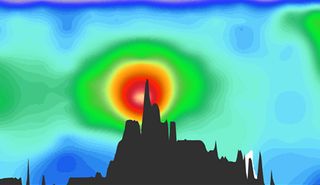Huge Iron-Rich Plume Discovered Beneath Atlantic Ocean

A large plume of iron-rich water has been discovered emanating from hydrothermal vents in the southern Atlantic Ocean, significantly increasing estimated global concentrations of this vital marine nutrient.
Dissolved iron is often a limiting nutrient for phytoplankton, meaning that its distribution across the ocean often controls where phytoplankton blooms: Regions lacking in iron are generally devoid of this floating plant life.
Iron reaches plankton through a variety of sources, including hydrothermal vents — underwater volcanoes that spew hot, mineral-rich water from beneath the Earth's crust — as well as iron-rich dust that blows off large deserts, like Africa's Sahara.
Finding a huge plume
Previously, researchers believed the world's fastest-spreading hydrothermal ridges of the Pacific Ocean — where tectonic plates are moving away from each other faster than the plates in the Atlantic Ocean — contributed significantly more dissolved iron than the slower-spreading ridges of the Mid-Atlantic Ridge. Now, a team of oceanographers from the Woods Hole Oceanographic Institution (WHOI) and the University of Liverpool in the U.K. have discovered an iron-rich plume of vent-water that stretches more than 620 miles (1,000 kilometers) from the Mid-Atlantic Ridge, suggesting that slower-moving ridges play a larger role in the global marine iron flux than originally thought. [Images: Deep-Sea Black Smoker Vents in Action]
The team discovered the plume in 2007 while on a cruise from Brazil to Namibia to map the chemical composition and microbial life of that stretch of ocean. At the time, not many researchers had studied mineral concentrations from this region, since ridges in the area were thought to be fairly inactive and only minor sources of important nutrients.
"People were just starting to see plumes of this extent, so that was the initial surprise," said Mak Saito, a researcher at WHOI and an author on the study. "We hadn't seen anything like this in this region at the time."
Sign up for the Live Science daily newsletter now
Get the world’s most fascinating discoveries delivered straight to your inbox.
Since then, more plumes of similar size have been discovered nearby, but this is the first study to show significant levels of iron associated with the plumes, Saito said.
Slow-moving ridges and iron
Scientists had previously disregarded Mid-Atlantic vents as an important source of iron, because iron concentrations were often inferred from concentrations of helium — a gas that spews in abundance from active hydrothermal vents. Since the Mid-Atlantic Ridge is slow moving and produces less helium than faster-moving ridges, the iron-to-helium ratios established in the Pacific Ocean suggested low iron concentrations when applied to the Mid-Atlantic Ridge. The new finding, however, shows the iron-to-helium ratio is actually 80-fold larger in the Mid-Atlantic Ridge than in the Pacific, suggesting that helium is not a good indicator of dissolved iron concentrations.
Given that slow-moving ridges account for a large portion of the hydrothermal vents along the global ocean floor, this finding will significantly improve global estimates of dissolved iron.
Though relatively high, these iron concentrations are still pretty low, making accurate measurements tricky. In the past, researchers found that samples were often contaminated by iron seeping off metal boats and sampling machinery, jeopardizing the accuracy of their data. Recent advancements in more precise analyzing techniques have allowed for more accurate measurements of small mineral concentrations.
"We are just now scaling up to begin to really see the complexities of ocean chemistry, for trace metals, in particular," Saito said.
Since trace metals determine the distribution of phytoplankton across the ocean, and phytoplankton play an important role in the global carbon cycle, these new advancements will help researchers better understand the key drivers in the global carbon cycle.
The group reported their findings earlier this week in the journal Nature Geoscience.
Follow Laura Poppick on Twitter. Follow Live Science on Twitter, Facebook and Google+. Original article on Live Science.

Most Popular

